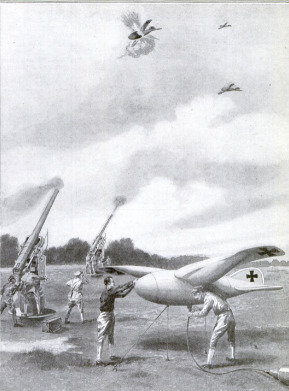Training the Anti-Aircraft Gunner
Contenuto
-
Titolo
-
Training the Anti-Aircraft Gunner
-
Article Title and/or Image Caption
-
Training the Anti-Aircraft Gunner. Why not use free balloons shaped like airplanes
-
extracted text
-
IN the good old days when Wild West Shows instead of motion pictures thrilled the youngster who yearned to lead the life of a scout cunning enough to outwit the wiliest Apache, Buffalo Bill would gallop around the tanbark ring, preceded by a rider who tossed glass balls into the air. Raising his trusty rifle to his shoulder, Buffalo Bill would fire at the balls tossed up in front of him, if not exactly with unerring aim, at least with an accuracy sufficiently startling to make every small boy on the bleachers put his two fingers to his mouth and whistle in joyous admiration.
Firing at an airplane with an anti-aircraft gun is about as hard as shooting at glass balls from horseback. Therefore, it has been suggested that the anti-aircraft gunner be trained by making him fire at small target-balloons shaped like airplanes.
No gunner needs so much practice as he who aims at elusive bomb-droppers. If the formerly inefficient anti-aircraft guns have become formidable, it is due entirely to experience gained in three years of warfare. What may not be expected of systematic preliminary practice?
Some Objections to Balloons
It may be objected to the target balloon scheme that the drift of the free balloons is much slower than the flight of a modern airplane. To this it may be replied that the smallness of the targets makes up for their slowness. Moreover, if they are sent up on a stormy day their drift may become as fast as sixty or seventy miles an hour.
To make target practice of this kind as realistic as possible, it would, of course, be advisable to shape the balloons somewhat like airplanes. This plan is now followed in training air gunners to fire at balloon targets towed from airplanes.
It is possible that even tissue paper bags floated by an alcohol flame might answer; but they could hardly attain great altitudes. The only real objection to the plan is the fact that in order to attain a great altitude it would be difficult to release the balloons so that they would actually drift into the range of the guns. After all, time enough must be given to them to reach a high altitude. There is also the difficulty that the real problem of aerial gunnery is that of determining how much time must be allowed for the speed of the airplane so that the projectile will actually hit it. It would never do to aim at the airplane where it is at the moment; it must be aimed at where it will be five or even seconds hence. If it were possible to attain a great height with free balloons while they are still within range, even the smallness of the target would not sufficiently make up for its relatively slow motion. The gunner does not get true practice in making the proper time allowance.
Why Not Use Dirigibles?
A plan that offers much better opportunity for practice to the anti-aircraft gunners would be to send up a swift and powerful dirigible balloon and let it tow a whole string of aerial targets, either balloons or kites, at the desired distance and height. Even when handicapped by the resistance to the air of the towed balloons or kites a dirigible could attain great speed, particularly when going with the wind. In that case, it could reach airplane velocity.
The weight of the towing cable would not prevent a powerful dirigible from rising to a great height and the cable could be made long enough to insure the safety of the dirigible from stray shots. The conditions, being under almost perfect control, could be sufficiently varied at will to give to the gunners ample opportunity to obtain a thorough training in estimating distances, angles and the necessary time allowances in placing shots at moving targets. Kites, of course, would be the most economical targets.
-
Autore secondario
-
Carl Dienstbach (writer)
-
Lingua
-
eng
-
Data di rilascio
-
1918-09
-
pagine
-
424-425
-
Diritti
-
Public Domain (Google digitized)
-
Archived by
-
Filippo Valle
-
Alberto Bordignon (Supervisor)

